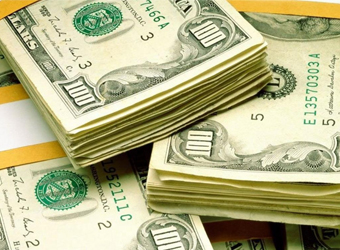Dollar prices retreated Tuesday as global equity markets showed some signs of stability after their recent rout, reviving risk appetite that has fueled bets against the U.S. currency on prospects of its narrowing interest rate advantage.
Still, many market players are not convinced the worst is over, with U.S. bond yields stuck at elevated levels ahead of Wednesday’s U.S. consumer price data that could rekindle worries about inflation.
“I think markets will remain shaky until (Federal Reserve Chairman Jerome) Powell’s congressional testimony on Feb. 28. Markets will try to test him until they hear his thinking,” said a trader at a U.S. bank.
The dollar’s index against a basket of six major currencies stood at 90.1392, having fallen 0.26 percent on Monday and edging away from Thursday’s half-month high of 90.569.
The euro traded at $1.2290, bouncing off last week’s low of $1.2206,though it was still more than two cents below its 3-year high of $1.2538 hit on January 25.
Buying the euro was one of the popular trades earlier this year on the view that the European Central Bank will scale back its stimulus later this year on the back of a strong recovery in the euro zone economy. Although many market players remain bullish on the euro in the long term, the currency lacks fresh catalysts for further gains amid headwinds from uncertainties ahead of Italy’s election in early March.
Although many market players remain bullish on the euro in the long term, the currency lacks fresh catalysts for further gains amid headwinds from uncertainties ahead of Italy’s election in early March.
In Germany, Chancellor Angela Merkel and the leader of the Social Democrats (SPD) face criticism from within their own parties over a new coalition deal that must still be approved by disgruntled SPD rank-and-file members.
The risk reversal spreads for euro/dollar options have widened in favor of euro puts, suggesting investors have grown more cautious about the chances the single currency will fall.
The British pound edged up to $1.3846 from Friday’s low of $1.3764.
Despite uncertainties around Brexit, the pound has been propped up by rising expectations the Bank of England will raise interest rates to curb inflation.
The revival of risk appetite dented the yen, with the dollar changing hands at 108.71 yen, recovering from Friday’s five-month low of 108.05 yen.
Global stock markets staged a strong rebound since a brutal sell-off that began late January on worries about rising inflationary pressure.
Higher inflation could prompt the Federal Reserve to tighten its policy faster than expected. Alternatively, if the Fed doesn’t act fast enough and falls behind the curve on policy, it could end up pushing up long-term bond yields. In either scenario, traders worry that U.S. growth could be hampered.
There were some indications such fears are beginning to subside, with Wall Street shares rebounding strongly on Monday and MSCI’s all-country world index of stock performance rising 1.2 percent.
Still, market players are on guard for more volatility.
The 10-year U.S. bond yield hit a four-year high of 2.902 percent while the 30-year yield rose to 11-month high of 3.199 percent.
“Rise in long-term bond yields lifts mortgage lending costs and is likely to cool the economy,” said Minori Uchida, chief FX analyst at the Bank of Tokyo-Mitsubishi UFJ.
Uchida said the dollar is likely to remain under pressure against the yen.
The South African rand slipped 0.3 percent to trade at 11.96 rand to the dollar, surrendering early gains made after reports the ruling African National Congress party executive committee had decided to “recall” or remove President Jacob Zuma as head of state.
Source: Reuters


